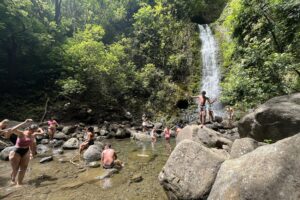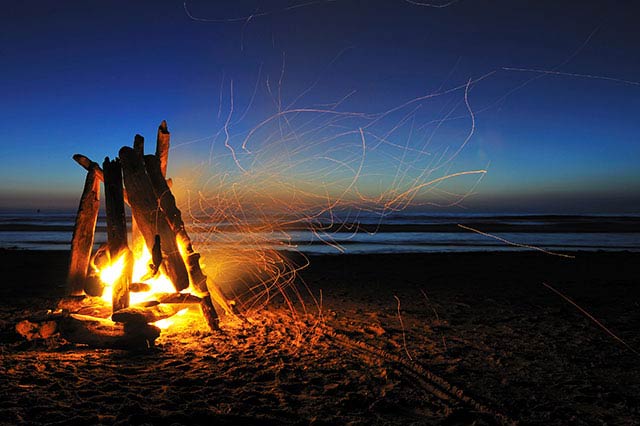Located in the verdant landscape of Oahu, Hawaii, the Lulumahu Falls Trail beckons hikers with its natural beauty and tranquility. This walking tour is not just a journey; It’s an experience that takes you deep into the heart of Hawaii’s beautiful outdoors. The trail is a favorite spot for those in the know offering a refreshing escape to nature. It represents a must-see destination for adventure enthusiasts and nature lovers looking to explore the trails of this stunning island with minimal traffic.

The purpose of this guide
When you embark on a hike to Lulumahu Falls, it promises the adventure of a lifetime, but it’s important to go prepared. This guide is dedicated to giving you everything you need to know for a fun and safe trip to the falls. From packing tips to trail etiquette, we’ve got you covered. Our goal is to focus your mind on the beauty that surrounds you, freeing you from any worries about the unknown.

Embracing the local vibe
The road to Lulumahu Falls is more than just a path through the foliage; In the center of the island is research. Step off the busy roads and you enter a world that tells stories of ancient Hawaii, connecting you with the spirit of the island every step of the way. The spectacular local scenery and sights that await you make this trip truly Hawaiian.
Getting Prepared for the Hike
Planning a trip to the Lulumahu Falls Trail involves a bit more than just showing up. To ensure a smooth and enjoyable experience, there are a few key steps and items you won’t want to forget.
Research and Permits
First thing’s first: you need a permit to hike to Lulumahu Falls. The trail is located on state land, which means regulations are in place to protect both hikers and the environment. Here’s how you can prepare:
- Obtain a Permit: A state hiking permit is required for each visitor. This can be easily obtained online through the official Hawaii government website dedicated to hiking permits. Just search for “Hawaii hiking permits” and find the section for Lulumahu Falls.
- Stay Updated: It’s also crucial to check for any recent changes in regulations or access before your hike. The state of Hawaii occasionally updates rules based on environmental and safety assessments.
What to Bring
Packing smart can make or break your hiking experience. Here are essential items to bring along:
- Appropriate Footwear: The trail can get muddy and slippery, especially after rain. Wear sturdy hiking shoes or boots with good grip.
- Water: Hydration is key. Bring at least one liter of water per person.
- Snacks: Energy bars, fruits, or nuts are great for a quick refuel.
- Rain Gear: The weather can change quickly, so it’s smart to pack a lightweight, waterproof jacket.
- Environmentally Friendly Practices: Remember, your choices impact the trail’s health. Follow the “Leave No Trace” principles by packing out what you bring in, staying on marked paths, and respecting wildlife.
Best Times to Hike
Embarking on the Lulumahu Falls hike requires an understanding of Hawaii’s unique weather patterns, and choosing the right time of year, as well as time of day, is key to maximizing your enjoyment.
- Weather Considerations: Oahu sees a tropical climate, meaning it can be rainy or sunny, regardless of the season. The driest months tend to be from April through October, while November to March marks the rainier season.
- Recommended Seasons: For optimal hiking conditions, plan your visit during the drier months. This will help you avoid excessively muddy trails.
- Crowd Management: If solitude is what you seek, early morning hikes are usually the best times to avoid crowds. A bonus to an early start is the softer light for photography and cooler temperatures.
- Late Afternoon Hike: Another less crowded time is later in the afternoon, but be sure to give yourself enough daylight to finish the hike safely.
The Trail Experience
The experience of hiking the Lulumahu Falls Trail truly starts the moment you step onto the path. But getting there is a crucial part of your journey, and knowing what to expect on the trail itself is equally important.
Getting There
Reaching the trailhead for your Lulumahu Falls hike is as follows:
- Driving Directions: The trail starts near the Pali Lookout off the Pali Highway. A short drive past the lookout, look for a small unmarked parking lot on the right side of the road. Use the “Nuʻuanu Reservoir” as your GPS destination, which should take you directly to the trailhead.
- Parking: Park in the unmarked lot. Be sure you aren’t blocking any roads or entrances.
- Starting the Trail: The trail is slightly hidden. Look for an opening in the bamboo forest across from the parking area, this marks the entrance to the trail.
Trail Description
Now, let’s dive into the details of the Lulumahu Falls Trail itself:
- Distance and Difficulty: The hike is roughly 2.5 miles round-trip and is considered moderately difficult. This is due to several stream crossings and potentially muddy conditions.
- Trail Features: As you journey along the trail, you’ll traverse lush forests, cross babbling streams, and ultimately reach a stunning waterfall vista. Be sure to pause at the ruins of the Old Hawaiian Summer Palace and at the reservoir for a scenic rest stop and photos.
- Stream Crossings: There are several stream crossings on the trail. These can be slippery, so proceed with caution. A hiking stick can be beneficial for added stability.
- Viewing Spots: One of the highlights of this hike is the breathtaking Lulumahu Falls, a perfect spot to relax, enjoy a snack, and marvel at the beauty of nature.
Wildlife and Plants
The trail is rich with diverse species—some of which should be admired from a safe distance. Here’s what you might encounter:
- Native Birds: Keep an eye out for the colorful ‘io, Hawaii’s native hawk. Listen for the distinctive calls of various native songbirds.
- Plant Life: The area is adorned with dense foliage including bamboo stalks, giant ferns, and the magnificent koa trees.
- Insects: Be mindful of the smaller inhabitants such as bees, which are essential pollinators for many native plants.
- Safety with Wildlife: If you spot any wild pigs or other larger animals, it’s best to keep your distance for safety.
Local Insights
Locals know the trail best, and their tips can transform your hike:
- Hidden Spots: Ask around or follow side trails (with caution) for undiscovered spots. One lesser-known treasure is a small waterfall aside from the main Lulumahu Falls that’s perfect for photos.
- Photography Opportunities: Near the falls, the light filters through the trees in a way that is particularly magical early in the morning.
- Respecting the Land: To ensure the trail remains pristine, stay on marked paths, do not disturb wildlife or remove plants, and take all trash with you.
Safety Considerations
Embarking on the Lulumahu Falls Trail is an adventure that brings you closer to nature. However, ensuring a safe hike requires preparation and awareness of potential hazards. Here, we outline crucial safety tips and how to address possible dangers on the trail.
Important Safety Tips
Before setting foot on the Lulumahu Falls Trail, keep the following safety tips in mind:
- Proper Footwear: Wear sturdy hiking shoes with good traction. The trail can get slippery, especially after rain.
- Weather Check: Always check the weather forecast. Avoid hiking during or immediately after heavy rains due to the risk of flash floods and slippery conditions.
- Stay Hydrated: Bring enough water for the duration of your hike. The Hawaiian sun can be intense, and dehydration is a risk.
- Inform Someone: Let a friend or family member know your hiking plans, including when you expect to return.
Potential Hazards on the Trail
Awareness of potential hazards can significantly enhance your safety on the trail:
- Stream Crossings: You will encounter stream crossings that can be slippery and dangerous, particularly after rain. Use a hiking stick for support and cross where the water is shallowest.
- Uneven Terrain: The trail includes uneven terrain and loose rocks. Pay attention to where you step to avoid trips and falls.
- Wildlife: While wildlife encounters are rare, maintaining a respectful distance is crucial. Do not attempt to feed or touch any animals.
- Getting Lost: The trail can be confusing at points. Stick to marked paths and consider using a trail map or GPS app.
Effective Responses to Hazards
Should you encounter hazards, here’s how to respond:
- In Case of Injury: Carry a basic first-aid kit. For minor injuries, administer first aid and rest before deciding to continue or turn back. For serious injuries, seek help immediately.
- If Lost: Stay calm. If you have a map or GPS, use it to reorient yourself. If severely lost, it is safer to stay in one place and wait for rescue than to wander further.
- During Flash Floods: If you notice rapidly changing water levels or hear a loud rumble upstream, move to higher ground immediately.
Post-Hike Recommendations
The Lulumahu Falls adventure doesn’t have to end after the hike. Nearby, you’ll find various attractions to explore, and local eateries that would provide the perfect end to a fulfilling day outdoors. We must also be mindful of our role in conserving this gripping landscape and how we can contribute to preserving its charm.
Nearby Attractions
Expand your travel itinerary with these points of interest:
- Nuʻuanu Pali Lookout: Just a short drive from the trail, this viewpoint offers panoramic vistas of Oahu’s windward coast.
- The Byodo-In Temple: Experience tranquility at this beautiful replica of a Japanese temple, nestled in the foothills of the Koʻolau Mountains.
- Local Eateries: Satisfy your post-hike hunger at nearby local businesses such as the ‘Ai Love Nalo, renowned for its superb vegetarian fare, or Waiahole Poi Factory for traditional Hawaiian cuisine.
Conservation Efforts
Hikers play a critical role in preserving the natural bounty of the Lulumahu Falls Trail:
- Minimize Impact: Keep the trail and its surroundings pristine by carrying your trash, sticking to marked paths, and not disturbing the wildlife.
- Support Conservation Groups: Get involved in local conservation initiatives to help protect and preserve this natural gem for future generations. The Nature Conservancy’s Hawaii chapter is an excellent place to begin.
- Advocate: Promote responsible hiking habits among your peers and in your community.
conclusion
Our journey through Lulumahu Falls brought us stunning nature, interesting trails and wonderful local tips. Coupled with important safety tips and post-travel tips, we hope this guide has prepared you for a trip to remember. But, at the heart of it all is respect, for the local environment and conservation efforts. Let us make this journey not only as tourists, but as stewards of the beauty and longevity of this earth. Here’s to creating good lasting memories of Lulumahu Falls!










